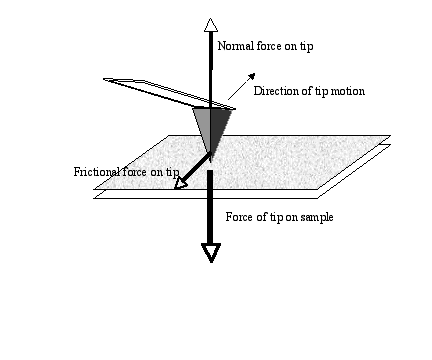Nano-technology – friction on the nano scale
Presenter: Andy Jackson
Harrisonburg High School , ajackson[at symbol]harrisonburg.k12.va.us
Va. SOL:
PH.14 The student will investigate and understand that extremely large and extremely small quantities are not necessarily described by the same laws as those studied in Newtonian physics. Key concepts include
Topic/Concept
Friction on, and the nature of, the nano scale.
Materials
Nano-manipulator
Atomic force microscope
Computer & internet connection
Willing and helpful University partner
Safety Considerations
none
Presentation
|
Students utilize an atomic force microscope located at James Madison University to conduct an experiment to measure how frictional forces depend on normal forces at the nano-scale. The students compare and contrast their nano-scale results with an analogous experiment conducted earlier on the macro-scale. While the AFM is physically located 2 miles across town, the laptop computer with nano-manipulator phantom joystick allows the student in the HS lab to manipulate and conduct experiments on the sample through the internet. This is not a simulation, but operation of the AFM in realtime through the web.
Dr. Scott Paulson, JMU watches as Aubrey uses the nano-manipulator to set up a nano scale friction measurement. |
Nano-Scale Friction
Earlier you were introduced to the world of the nano-scale and two new pieces of equipment; the nano-manipulator and the Atomic Force Microscope (AFM). Today we will be conducting an experiment analogous to the Frictions lab we did earlier in the year.
Recall that in the frictions lab you pulled on the cart with the force probe to determine the frictional force. You added 1 kg masses to the cart to increase the weight of the system and thus increased the normal force. In other words, the normal force was your independent variable and the frictional force was your dependent variable. In the Nano-Scale Frictions lab a manipulation on the computer will increase the downward force of the probe on the sample. You will use the nano manipulator to instruct the computer to move the AFM tip back and forth across a sample. As the tip moves to the right, friction on the tip will be exerted to the left. This force will twist the cantilever a bit. As the tip moves to the left the friction will twist the cantilever the other direction. The forces and motion are diagramed below.

What will the data look like?
The data you will collect is the normal force and the frictional force. The data collected is not in Newtons, but is in a unitless form that is directly proportional to the force in Newtons (or nano-Newtons). The AFM tip will scan back and forth a few times while the contact force remains constant. As the AFM tip scans it will be tilted by the frictional force. The amount of tilt is directly proportional to the force of friction. Data for the force of friction will be numeric values that when graphed look something like this:

How do I get the force of friction from this?
Half the difference between the values of the upper plateaus and the lower plateaus is the force of friction.
- Use Logger-Pro features to determine the average value of each plateau and the uncertainty of this value (standard deviation of the mean)
- Find the difference between the values of adjacent plateaus. The uncertainty in this value is the sum of the uncertainties from #1.
- Average the several different values you got for your run and use the average uncertainty from step #2 to represent the uncertainty in your final value of frictional force.
Create an organized table to present this information. Other groups will be collecting the same data but with a different amount of force pressing the tip against the sample. Collect the data from all the groups to complete the table below.
|
Normal Force (arb) |
Frictional force (arb) |
Ff uncertainty (arb) |
Coefficient of friction |
|
|
|
|
|
|
|
|
|
|
|
|
|
|
|
|
|
|
|
|
|
|
|
|
|
|
|
|
|
|
Plot a graph of Frictional force Vs Normal Force. Include error bars for Frictional force. What does the shape of the graph tell you about the coefficient of friction on the nano-scale as compared to the coefficient of friction on the macro-scale?
.
Teacher Tips Regarding Lab
This has been a possibility for my students through a partnership between myself and Dr. Scott Paulson at James Madison University. This has been a great opportunity for my students to experience aspects of physics that I believe will be a rich field during their life time. My school’s top science students get a chance to be wowed and taught for a couple of days by a JMU physics professor. It is my hope that the AFM and nano manipulator are a source of great interest that may attract some students to the fields of physics or engineering. Most major colleges and universities have Atomic Force Microscopes and hopefully are looking for chances to partner with high schools.
Sources & References
|